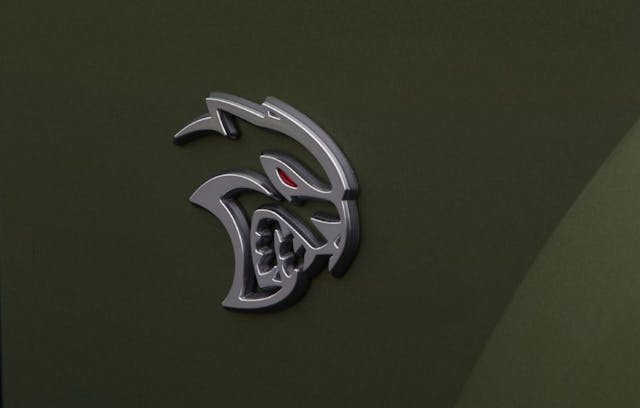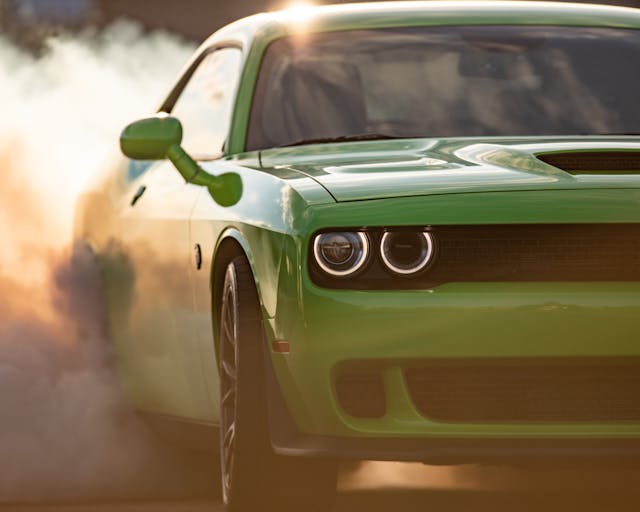Media | Articles
Depreciation Has Come for the Dodge Challenger SRT Hellcat
Hear that sound? What might otherwise be identified as the roar of a big V-8 accompanied by a shrieking supercharger is actually Dodge Challenger SRT Hellcat values settling back to earth.
That’s actually something to be excited about, but more on that in a second.
The last decade has been a good time to be a car enthusiast, especially if brawny V-8 muscle is your thing. Each of the Big Three crammed some monster engines into the bays of otherwise sane vehicles, though it was Dodge’s myriad Hellcat-equipped products, all wail and tire smoke and outrageous colors, that managed to become the most recognizable emblems of Detroit’s latest muscle era. The 707-horse Challenger SRT Hellcat wasn’t downright affordable, but at a base price of $60,590 in 2015 (about $81,450 today) it at least somewhat democratized ridiculous power off the showroom floor.
As great a time as it’s been, the curtain comes for all of us (though Stellantis provided several encores with the final-edition-last-call-extended-name-Mopars and Jeeps). This golden era has mostly come to a close, especially if you’re considering what’s freshly available on new-car lots.
But for many, the real prime time occurs once depreciation sets in and these vehicles become truly accessible. And, at least based on the secondary market sales trajectory of the poster-child Challenger SRT Hellcat, it looks like that moment may be upon us.
Marketplace
Buy and sell classics with confidence
It took a while to get here. Back in olden days of the pre-pandemic era, Hellcats and other sought-after cars depreciated at rates expected of a used performance car. The car hobby’s valuation boom of 2021-23 put a temporary halt to that, and for a moment it seemed as though—especially with an electric future ahead of us—anything with V-8 power and personality would at least hold its value.
Public sales of 2015-2018 Challenger Hellcats indicate that’s no longer the case.
Since February of this year, the average sale price is down nearly 10 percent, from $61,959 to $56,690, and aside from a brief bump last winter, that number has been on a steady decline since its 2023 peak of $63,898. Challenger Hellcats hadn’t seen values in that range since August of 2018. It appears that these cars have now well and truly returned to their normal depreciation curve.
What’s more, the 2015-18 narrow-body Hellcats represented in this data had been driven a median of 732 miles a year. You read that right—these cars aren’t still in their wrappers, but they aren’t far off. Time will tell, but this data presents a bit like the early stages of the plight of Buick Grand Nationals that got parked when new. Hellcats will certainly be collectibles in the future, but the return they deliver will be primarily driven by the entry price. In the meantime, a few more miles on the odometer won’t hurt much.
To us, $55k (and likely less in the near future) for a nearly-new, 707-horse ball of personality sounds like there’s still a little bit of shine left on this era, after all.

***
Check out the Hagerty Media homepage so you don’t miss a single story, or better yet, bookmark it. To get our best stories delivered right to your inbox, subscribe to our newsletters.













It was the best scam Dodge ever pulled. Sell people brand new cars that will never be driven. Warrantys run out while the car sits in the garage with zero miles.
Then get a bunch od suckers on the line for “last Call” models, sell so many of those that the market will be flooded with them for the next 50 years.
It was smart on Dodge’s part considering that their current and future sales will be in the toilet.
There’s not much of a legacy to the original Challengers, kind of like the PT Cruiser “legacy” rerun. When your best ideas are 50 years old, it’s time for some new blood. The silhouette from a distance is about the only common link, probably not a single identifiable part in common. Their bloated presence was a disappointment for me as an owner of one of the originals.
Great, affordable Hellcats to the 15% that swear thru traffic at 90 and engage in street takeovers. I don’t think there is an intersection in my town that doesn’t have burnouts and donuts in it
Dodge is hilarious for coming up with these lengthy model names. Challenger RT Scat Pack Shaker Widebody and Challenger SRT Hellcat Redeye Widebody Jailbreak are both mouthfuls of trim names.
I predict these will bottom out as used cars soon and then start their steady climb. I remember back in 2019 seeing the 2013-14 GT500’s go for around 45-50k. At the time I thought, “Great! In a few years maybe I can get one under 40k.” (35k is my sweet spot). Well that never happened. Between the post covid insanity and the realization of what they were, good lucking finding one now under 60k. So if you want a Hellcat, have at it!
With all the talk on Challengers, what does this look like for the Chargers? What about the Redeye Chargers? Been looking the direction of a 22 or 23 Charger Redeye with the CT5V Blackwing (6 speed).
Hi David,
I don’t have hard numbers in front of me, but we’ve seen more Dodge special editions of both cars not meet reserve at auction over the course of the last year. That’s evidence that it’s becoming a stronger buyer’s market, though I’d suspect the Redeyes would be subject to a slower rate of depreciation compared to the base Hellcats.
Thanks! now time to find my Plum Crazy, no sunroof, Brass monkey wheeled, Redeye Charger… (or Sublime, or Hemi Orange, or B5). As Tom Cotter says, “Happy Hunting.”
A more than worthy successor to the Wildcat and the 2000 horse Pratt and Whitney Double Wasp deserves honorable mention. Yet I kind of like the P-47 Thunderbolt ( Jug ) that shared that same engine more. Of course in the European theater the Mustang is hard if not impossible to argue. In the Pacific the Corsair F-4U , with that gullwing design, you’d have to admit, has that just right- ” If it looks good it flies good – design.
LOL. Wrong magazine…
55 g- Wrong car obviously , but “if you can’t say something nice…why ? “
Please, please, please, once and for all, get your facts right about the car. This is the second time I have seen a Hagerty article refer to a non-existent body style: there are only two body styles of the Challenger – the standard body, and the wide body. There is no NARROW body. A Narrow body means it is less than a Standard body, or did we forget what all these words are supposed to mean?
These cars will always attract a certain class of people. They buy what they can’t afford, park it in front of the trailer and eventually the repo man takes it back. Just like a mustang or Camaro, most end up ragged out, stolen or destroyed. It’s all about demographics.
would love opinions on where this leaves values of show room low miles original 2008 SRT8, and anniversary trim cars produced with number plates sold as limited editions. Dodge would always say this is it and it was not true. Will these be holding value since there may have been 20,000 hellcars out there?
You’re better off buying the 1 year limited Hellcat Durango…………..oh wait
I’m one of the old guys who bought a ’23 charger wide body skat pack. I prefer to avoid turbochargers. I will drive it a few hundred miles per year to keep the moths and cobwebs and condensation away. It won’t make me rich, but there will be added value to the “Last Call” V-8 down the road. If I’m wrong, I’ll just enjoy driving it in the future. I understand that the onboard computer tracks how many “launch” episodes have been engaged, so having none, it will be clear that it’s a “cream puff.” (That term alone betrays my age!!)
These and any other vehicle that rely on electronics and the associated sensors will never be long term collectibles. Once the sealed electronics or sensors go bad and you cannot get a replacement you are sunk. And have a nice realistic sculpture. The early 70’s and older cars were not digital.
I’m sure the aftermarket community will differ, just as updated parts are available for 1960’s and 1970’s cars now. I’m safe to assume that the electronics you speak of will be considered archaic and easy to reproduce in the future – after all race electronics, suspension, drive line and body components are being made now for these cars, so the tooling exists already.
The issue going on here is this. Yes, perhaps they are beginning to go down a bit right now, but has anyone considered that it is because of bank repossessions as people find out a $1250.00 to $1600.00 monthly car note is really more than they emotionally wished they could afford? That, and right now they are being purchased on the cheap by dealers as they cross the bank auction block, dealers can pass the savings on to the consumer who doesn’t mind that their butt wasn’t the first in the driver’s seat.
The other thing is that now as Hellcats become more affordable on the used market, it’s just a matter of time before they get into the hands of people who will wrap them around trees and telephone poles, or roll them over into football shaped wrecks!
Also, buying a used Hellcat just may be like going to a house of ill repute looking for a wife… you have no idea on the maintenence record or if it was driven by someone who thought they were Steve McQueen!
It’s just a matter of time before they are valuable again, just like my buddy’s immaculate 1970 440 Six Pack, Pistol Grip 4-speed, Air Grabber hood Roadrunner is now. It’s generational, if you’re willing to hold on to it like I am mine.